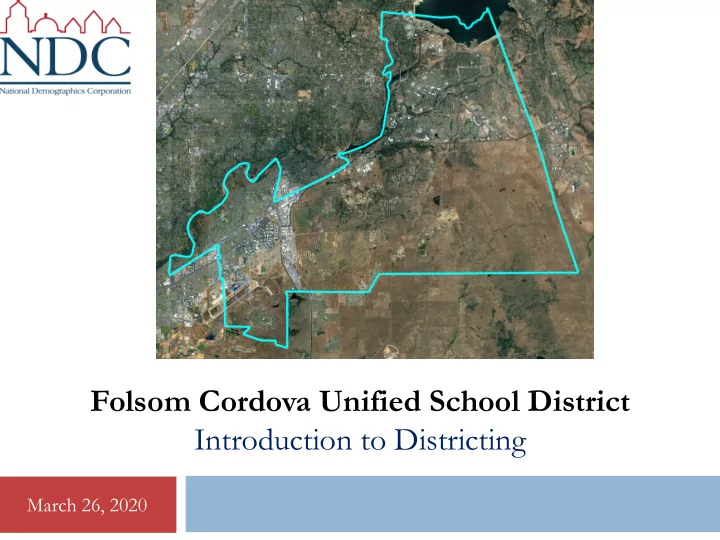

Folsom Cordova Unified School District Introduction to Districting March 26, 2020
Districting Rules 2 Federal Laws Traditional Redistricting Principles Communities of interest Equal Population Compact Federal Voting Rights Act Contiguous No Racial Gerrymandering Visible (Natural & man-made) boundaries Respect voters’ choices / continuity in office Planned future re g gro rowth March 26, 2020
Category Field Count Pct Category Field Count Pct Total Pop 115,536 ACS Pop. Est. Total 123,640 Hisp 16,642 14% age0-19 32,778 27% Age NH White 73,093 63% age20-60 67,784 55% Total Pop NH Black 6,654 6% age60plus 23,078 19% Asian-American 15,684 14% immigrants 24,333 20% Immigration Total 82,780 naturalized 12,876 53% 3 Hisp 9,834 12% english 85,175 73% Citizen Voting Language spoken NH White 56,315 68% spanish 9,830 8% Demographic Age Pop at home NH Black 4,297 5% asian-lang 9,848 8% Summary Asian/Pac.Isl. 285 1% other lang 11,234 10% Speaks Eng. "Less Total 66,594 Language Fluency 11,307 10% than Very Well" Each of the five Latino est. 6,949 10% Education hs-grad 42,932 51% Spanish-Surnamed 6,243 9% (among those age bachelor 22,509 27% trustee areas must Voter Registration Asian-Surnamed 3,925 6% 25+) graduatedegree 13,248 16% contain about 23,107 (Nov 2018) Filipino-Surnamed 939 1% Child in Household child-under18 15,220 33% residents. Pct of Pop. Age NH White est. 51,290 77% employed 60,150 62% 16+ NH Black 3,595 5% income 0-25k 5,944 13% Total 47,166 income 25-50k 7,665 17% Household Latino est. 4,383 9% income 50-75k 7,010 15% Income Spanish-Surnamed 3,938 8% income 75-200k 19,870 43% Voter Turnout Asian-Surnamed 2,558 5% income 200k-plus 5,400 12% (Nov 2018) Filipino-Surnamed 667 1% single family 35,817 75% NH White est. 37,258 79% multi-family 11,860 25% Housing Stats NH Black 2,371 5% rented 17,235 38% Data e excludes the Total 52,514 owned 28,654 62% pr prison po n popu pulation. n. Latino est. 4,939 9% Spanish-Surnamed 4,437 8% Total population data from the 2010 Decennial Census. Surname-based Voter Voter Turnout Registration and Turnout data from the California Statewide Database. Latino voter Asian-Surnamed 2,663 5% (Nov 2016) registration and turnout data are Spanish-surname counts adjusted using Census Filipino-Surnamed 691 1% Population Department undercount estimates. NH White and NH Black registration and turnout counts estimated by NDC. Citizen Voting Age Population, NH White est. 40,930 78% Age, Immigration, and other demographics from the 2014-2018 American March 26, 2020 Community Survey and Special Tabulation 5-year data. NH Black est. 2,816 5%
Latino Share of Total CVAP 4 Lat atinos ar are not p par articular arly concentrated anywhere in t the District. These two red Census Blocks contain a total of only 6 people. March 26, 2020
African-American Share of Total CVAP 5 Af African-Americans are n not particularly c concentrated anywhere in in the D e Dis istrict ict. March 26, 2020
Asian-American Share of Total CVAP 6 Asia sian-Americans are s somewhat conc ncent ntrated in S n SE F Folsom and nd Rancho C o Cor ordova s sou outh of of Highway March 26, 2020
Defining Communities of Interest 7 1 st Question: what is your neighborhood or community of interest? A Community of Interest is generally defined as a neighborhood or community of shared interests, views, problems, or characteristics. Possible community feature/boundary definitions include: School attendance areas Natural neighborhood dividing lines, such as highway or major roads, rivers, canals, and/or hills Areas around parks and other neighborhood landmarks Common issues, neighborhood activities, or legislative/election concerns Shared demographic characteristics Such as similar levels of income, education, or linguistic isolation 2 nd Question: Does a Community of Interest want to be united in one district, or to be divided to have a voice in multiple elections? March 26, 2020
Attendance Zones 8 Attendance zones are the most common “community of interest” in school districts, but the more common policy directive is to try to ensure multiple representatives for each attendance zone where possible. March 26, 2020
Sample Compact Maps 9 Glendale Unified Glendora Unified Examples of highly compact maps, with nooks and jogs driven only by equal population requirements. March 26, 2020
Sample Multiple-Representative Maps 10 Redwood City School District Central Unified Examples of maps where a desire to ensure Trustees represented multiple school attendance areas (to avoid Balkanizing the District), led to policy-driven but non- compact maps. March 26, 2020
Public Hearing & Discussion 11 Should each attendance zone be kept together in one trustee 1. area or have multiple representatives? What are other communities of interest that should be 2. considered when drafting maps? March 26, 2020
Recommend
More recommend